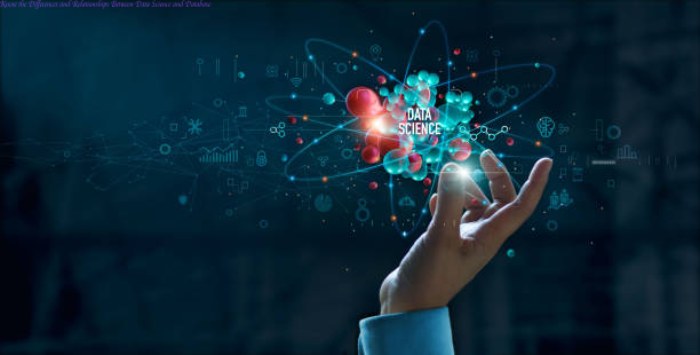Know the Differences and Relationships Between Data Science and Database

Know the Differences and Relationships Between Data Science and Database
Table of Contents
What is a Database, Exactly?
Data science is one of the trendiest fields, and I don’t see it changing anytime soon, not with our increasing reliance on data daily. Data science is collecting, cleaning, analyzing, visualizing, and utilizing data to better our lives.
Dealing with enormous amounts of data can be challenging for data scientists. The data we need to analyze and assess most of the time surpasses our devices’ capability (RAM size). Keeping the data on the hard disc may cause our programmes to perform much slower.
Not to mention that we need this data organized in some way to make sense of it and handle it efficiently. Databases come into play in this situation.
What exactly is Data Science?
To extract insights and information from data, data scientists combine domain experience, programming skills, and an understanding of arithmetic and statistics. Machine learning algorithms are used to process numbers, text, images, video, audio, and other data to construct artificial intelligence (AI) systems that perform tasks that ordinarily need human intelligence. As a result, these systems generate insights that analysts and business users can use to generate revenue.
Data science, artificial intelligence, and machine learning are essential to businesses.
Organizations that want to stay in this age of big data should be competitive, regardless of industry or size, and must build and execute data science skills quickly or risk being left behind.
Machine learning and artificial intelligence are used in data science to extract relevant information and anticipate future trends and behaviours.
Access to big data has risen due to technological advancements, the internet, social media, and technology usage.
As technology progresses and extensive data collecting and analysis tools get more sophisticated, the area of data science is expanding and the need for experts as well. Data Scientist training online can help to provide knowledge.
Difference
A database is a structured collection of data that can be accessed in various ways and kept in the memory of a computer or in the cloud.
Most of your initiatives as a data scientist will require you to create, develop, and interact with databases. Sometimes, you’ll need to start from scratch; other times, you’ll only need to know how to connect to an existing database.
So, what’s the distinction between the two? Finally, there is a contrast between relational and linear algebra. In databases, you define relationships between objects by encoding them in tables and connecting entries from different tables using foreign keys. The invention of a query language, a declarative explanation of what you want to get from the database, leaving the optimization of the query and the technical specifics of how to do it successfully to database specialists, was possibly the most important insight of the database world.
The machine learning community has its roots in linear algebra and probability theory. Objects are typically represented as feature vectors, a collection of integers describing the object’s numerous attributes. Data is generally collected in matrices, in which each row represents an object and each column indicates a feature, similar to a database table.
The Fundamental Difference Between Data Management and Data Science
An organization’s Data Management function is the overall responsibility of enterprise data acquisition, storage, quality, governance, and integrity, supervising the design and execution of all data-related policies inside that corporation. The Data Management team, on the other hand, merely manages the data assets and is rarely involved in the core technological uses of the data. The Data Management function is in charge of all data. In the webcast, Data Management vs Data Strategy, Peter Aiken highlighted “prioritizing organizational Data Management demands versus Data Strategy needs.”
the Data Science function conceptualizes, develops, executes, and practises all “technical applications” of data assets in an organization. In this context, “technical applications” refers to the science, technology, craft, and business practices involving corporate data.
The connection between data science and databases
A database is a structured collection of data that can be accessed in various ways and kept in the memory of a computer or in the cloud. Most of your initiatives as a data scientist will require you to create, develop, and interact with databases.
Everything we use daily is based on massive amounts of data. When you initially launch Netflix, it will suggest what you should watch next based on your previous selections. When you launch the Spotify app, it provides songs based on your preferences.
Data collection and analysis is one method for tailoring each of our experiences. It is a method of developing a single product that everyone may utilize.
However, to accomplish this, the data must be stored and organized in a location that is easy to access, allows for quick communication, and is safe.
Databases make structured storage safe, efficient, and rapid. They create a framework for storing, organizing, and retrieving data. Databases alleviate the strain of determining what to do with your data in each new project.
Data is the most essential part of data science; there is no data science without it. Any data scientist who wishes to develop in their career and broaden their knowledge base must be capable of designing, creating, and communicating with databases.
SQL stands for Structured Query Language.
Structured Query Language is a powerful computer language for manipulating data in relational database management systems (RDBMS). SQL is a simple language that is extremely powerful and efficient. SQL is a programming language developers and data scientists use to add, delete, update, and execute certain operations on relational databases. Various institutes provide professional certificate courses in Data Science.
SQL can be used for more than just basic database operations; it can also be used to create databases and analyze data.
Also read:-Top 5 Benefits of Using Payroll Services for Small Businesses




